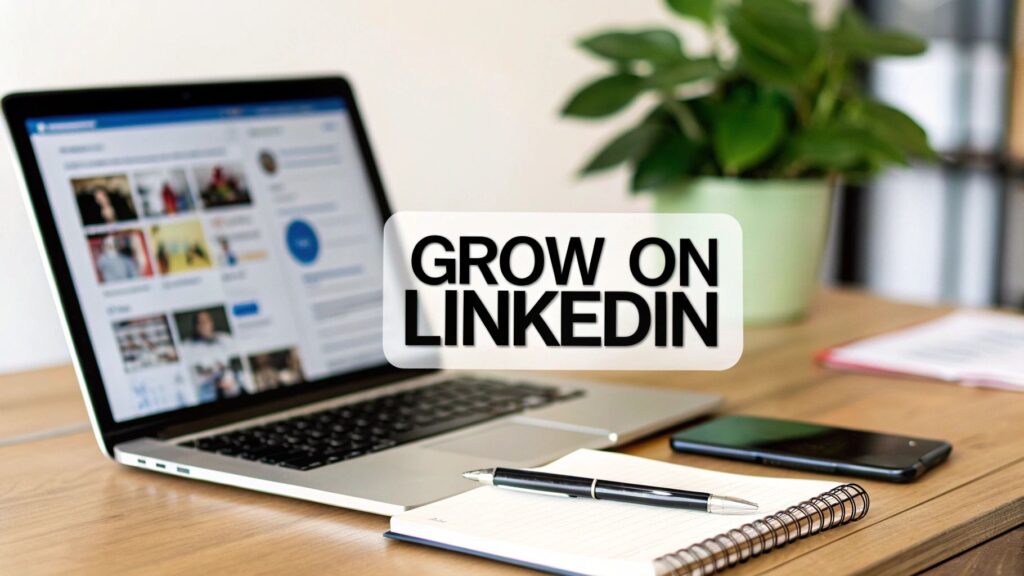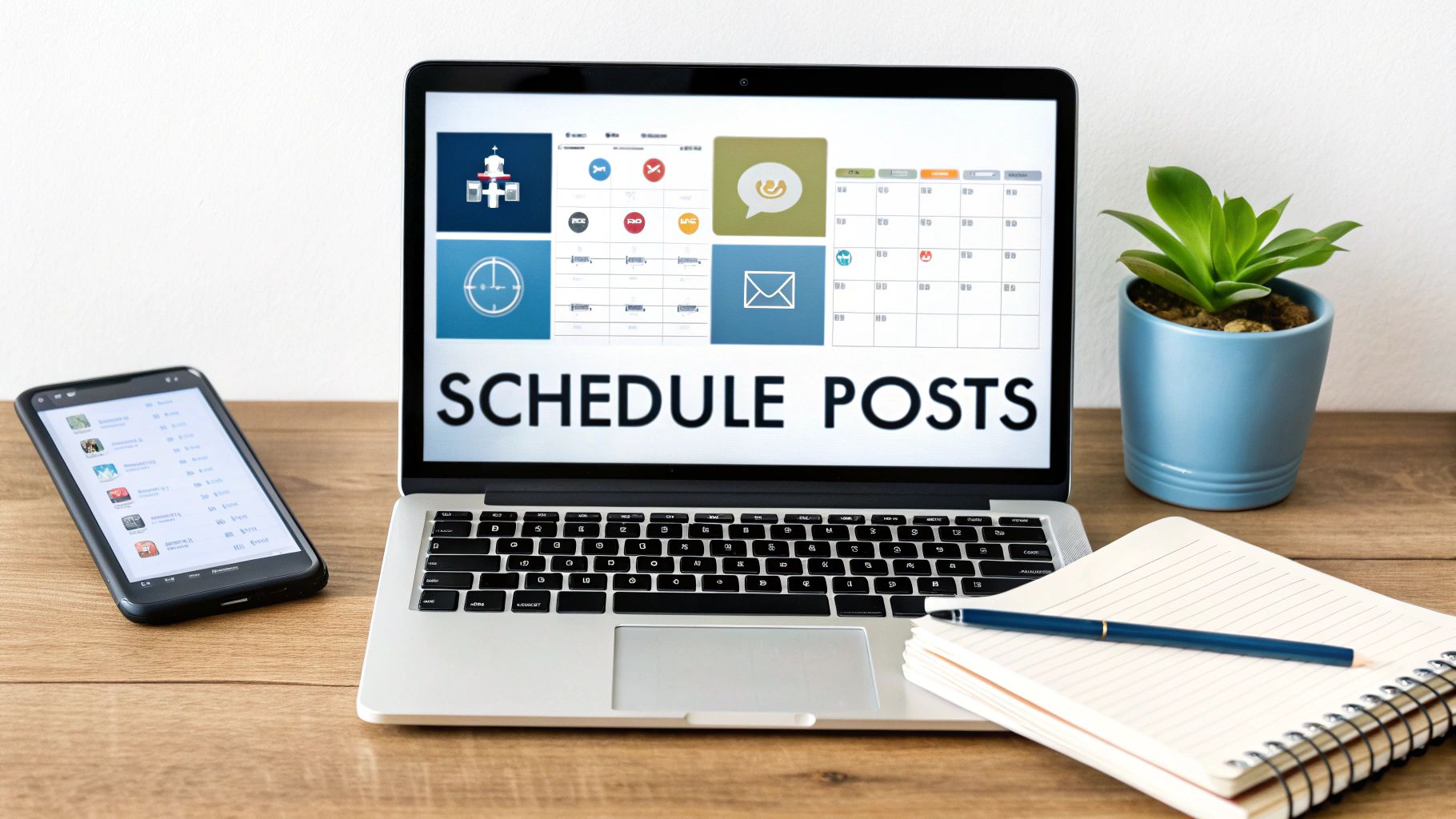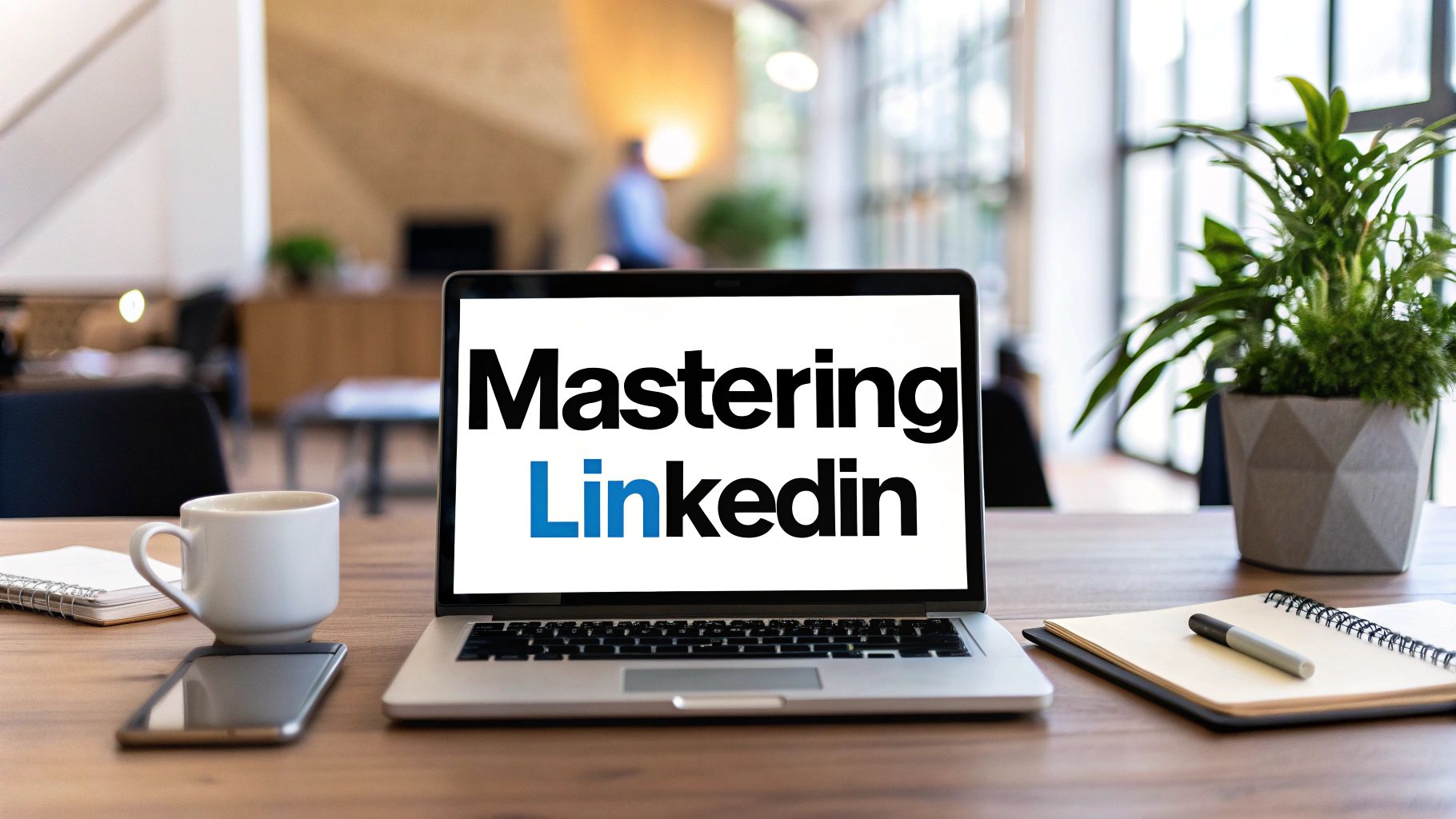Before you even think about posting content or reaching out to new connections, your LinkedIn profile has to be rock-solid. Think of it as the foundation of your entire strategy. Get this right, and everything else you do on the platform will be ten times more effective.
Build a Profile That Actually Attracts Opportunities
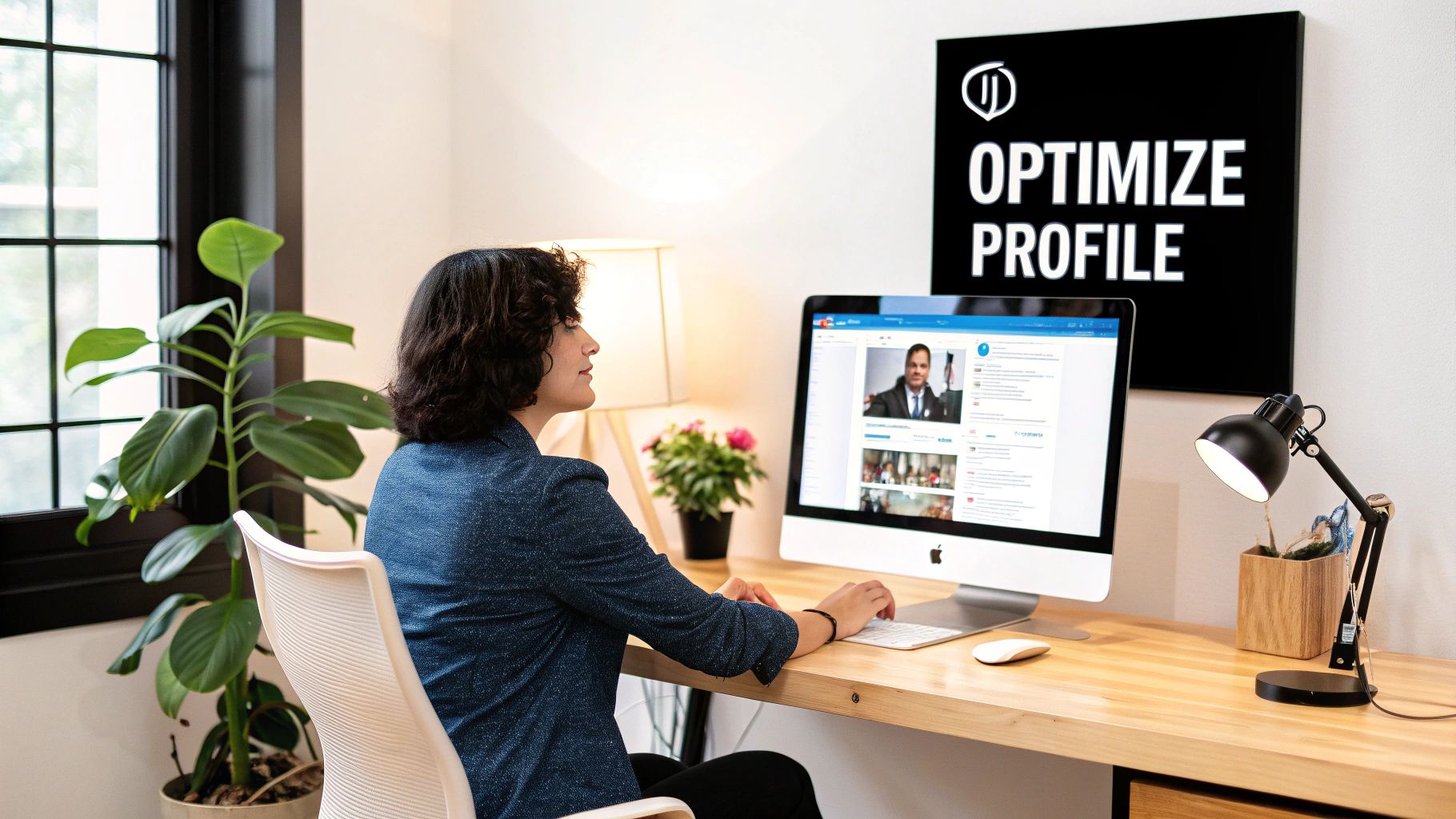
Your profile is more than just a digital CV. It's your personal landing page, your 24/7 salesperson, and often the first impression you’ll make on a potential client, hiring manager, or partner. A lacklustre profile can kill your growth efforts before you’ve even started.
It's not about just listing jobs. It's about crafting a narrative that instantly answers three key questions for anyone who lands on your page:
- Who are you?
- What problem do you solve?
- Why should they care enough to connect?
Craft a Headline That Communicates Value
Your headline is the most valuable piece of real estate on your entire profile. I see so many people waste it by simply putting their job title, like "Marketing Manager at ABC Company." That tells people what you are, but not what you do for them. It’s a huge missed opportunity.
Treat your headline like a mini-pitch that screams value. For instance, instead of just "Software Developer," try something like "Software Developer | I Help SaaS Startups Scale with Clean Code & Cloud Architecture." See the difference? It immediately tells visitors who you help and how you deliver results.
Tell Your Story in the About Section
This is where you get to connect with people on a human level. Ditch the stuffy, third-person bio and write in a natural, conversational first-person voice. You're not writing a press release; you're starting a conversation.
A powerful 'About' section usually follows a simple narrative:
- Start with a hook: Open with a statement that resonates with your target audience's biggest challenge.
- State your mission: Clearly explain what you do, who you serve, and the problems you're passionate about solving.
- Show, don't just tell: Weave in your key skills and accomplishments with specific, punchy examples.
- Add a clear call-to-action (CTA): What’s the next step? Tell them. Whether it's to connect, visit your website, or send you a message, guide them.
This section is a cornerstone of your personal brand. For more detailed strategies on this, check out our deep dive on how to build your brand.
Optimise Your Visuals for Credibility
People are visual. We make snap judgments based on what we see. Your headshot and background banner are the first things people notice, and they're critical for establishing instant credibility.
Your profile picture needs to be a high-quality, professional shot where you look friendly and confident. No holiday snaps or cropped group photos. And as technology advances, many professionals are exploring new ways to get that perfect shot; it's worth seeing how AI-generated LinkedIn profile pictures are changing the game.
Your background banner is a mini-billboard. It should reinforce your headline and brand identity. Use it to display your company logo, a tagline, contact info, or a powerful image that represents what you do. In a competitive market like LinkedIn in Germany—with roughly 22.1 million users as of May 2025—these visual cues are what make you memorable.
To help you get started, here's a simple checklist to run through. Think of it as your quick-reference guide for making sure every part of your profile is working hard for you.
Your LinkedIn Profile Optimization Checklist
A quick-reference guide to the essential elements for a high-impact LinkedIn profile that drives connections and opportunities.
| Profile Element | Strategic Purpose | Actionable Tip |
|---|---|---|
| Profile Picture | To establish immediate trust and approachability. | Use a high-resolution headshot where you are smiling and making eye contact. Avoid distracting backgrounds. |
| Background Banner | To visually reinforce your brand and value proposition. | Customise it with your company logo, a tagline, or an image that represents your industry. |
| Headline | To communicate your unique value in under 3 seconds. | Go beyond your job title. Use a formula like "I help [Target Audience] do [Benefit] by [Your Skill]." |
| About Section | To tell your professional story and connect with your audience. | Write in the first person. Start with a hook, explain the problems you solve, and end with a clear call-to-action. |
| Experience Section | To provide proof of your skills and accomplishments. | For each role, use 2-3 bullet points with quantifiable results (e.g., "Increased sales by 25%"). |
| Skills | To get endorsed by others and appear in relevant searches. | Pin your top 3 most relevant skills. Ask colleagues for endorsements to add social proof. |
| Custom URL | To create a professional, easy-to-share link to your profile. | Edit your public profile URL to be linkedin.com/in/yourname. It looks cleaner on business cards and email signatures. |
Working through this checklist ensures you haven't missed any of the small but crucial details that separate a basic profile from one that actively generates opportunities.
Develop a Content Strategy That Creates Authority

With your profile dialled in, the real work begins: showing people what you know. Just posting on a whim is like shouting into the void—it’s all noise and no signal. If you genuinely want to grow on LinkedIn, you need a solid content strategy that gives your target audience real value, time and time again.
This doesn't mean you need to quit your day job and become a full-time creator. It's about a simple shift: moving from a passive scroller to an active, valuable contributor whose insights people actually want to see. And that journey starts with deciding what you're going to talk about and how you'll say it.
Define Your Core Content Pillars
Let's be real, you can't be an expert in everything. The people who make a real impact on LinkedIn are known for a handful of specific topics. These are your content pillars—the two or three core themes you want to "own" in the minds of your network.
To find yours, think about where these three things overlap:
- What you know: Your hard-earned professional expertise and industry knowledge.
- What you're passionate about: The stuff you could talk about for hours without getting bored.
- What your audience needs: The problems, questions, and pain points your ideal connections are grappling with.
For instance, a marketing consultant's pillars might be "B2B Lead Generation," "Brand Storytelling," and "Marketing Automation." A software developer could focus on "Cloud Architecture," "AI Integration," and "Team Leadership." Nailing down these pillars gives your content a laser focus and helps you build a strong reputation in a specific niche.
The biggest mistake I see is people being too broad. The old saying, "if you're trying to help everyone, you're helping no one," is especially true on LinkedIn. A tight focus brings in a much more engaged and relevant audience.
Choose the Right Content Formats for Your Message
Different ideas land better in different formats. A smart content strategy mixes things up to keep your audience engaged and cater to how people like to consume information. Your job is to pick the format that will make your message hit hardest.
Here are a few popular options to play with:
- Text-Only Posts: Perfect for telling stories, sharing a personal take, or asking a provocative question. Their simplicity is their strength, and they often spark great conversations.
- Carousels (PDF Documents): These are fantastic for breaking down complex ideas into simple, swipeable slides. Think of them as mini-guides, checklists, or visual tutorials.
- Polls: An incredibly easy way to get immediate engagement and take the pulse of your audience. A single poll can kick off a massive debate in the comments.
- Image Posts: A powerful visual can stop the scroll and give your words more punch. Use high-quality photos, infographics, or even a behind-the-scenes shot.
Give them all a try and see what your audience responds to. For a closer look at how to frame your content, our guide has some great tips for crafting a powerful LinkedIn post.
Build a Simple and Sustainable Content Calendar
Consistency beats genius every single time. You don't need a complex, colour-coded spreadsheet; you just need a plan you can actually stick to. Posting consistently—even just two or three times a week—tells both the LinkedIn algorithm and your audience that you're a reliable voice in your space.
Start with a simple weekly rhythm based on your pillars.
- Tuesday: Post a text-based story related to Pillar 1.
- Thursday: Share a carousel that breaks down a concept from Pillar 2.
- Friday: Run a poll asking about a trend related to Pillar 3.
This kind of structure takes away the daily panic of "what do I post today?". You can even batch-create your content for the week in one session, ensuring you stay on track even when things get hectic. Planning is everything, and you can find more in-depth frameworks by exploring a solid content strategy for social media.
Remember, the first hour after you post is critical. The algorithm shows your content to a small group of people first. If it gets meaningful comments quickly, LinkedIn will push it out to a much wider audience. The trick is to write posts that don't just get likes, but start real conversations. Always end with an open-ended question and make sure to reply to every comment to keep the discussion going.
Master Networking That Opens Real Doors

Let’s be honest: a massive network of random connections is more of a vanity metric than a real asset. Meaningful growth on LinkedIn stems from building your network with intention. It's about cultivating a community of relevant peers, potential mentors, and future clients who can genuinely open doors for you.
So, it’s time to stop the blind "Connect" clicks and start building relationships that count.
The cornerstone of smart networking is personalisation. A generic, empty connection request is forgettable and easy to ignore. One that shows you've done your homework, however, is compelling. This simple shift takes you from being just another number to a thoughtful professional worth knowing.
Craft Connection Requests That Actually Get Accepted
The goal is simple: get them to click "Accept." To do that, you have to instantly answer their unspoken question: "Why should I connect with you?" The default request leaves that question hanging in the air. A personalised one nails the answer.
Before you even think about sending an invite, take thirty seconds to glance over their profile. Look for a genuine point of connection. Did you go to the same university? Did they just share an article you found insightful? Do you have a mutual connection you both respect?
A killer request is short, specific, and focuses on them, not you.
- What to avoid: "I'd like to connect with you." (This says nothing.)
- What to do: "Hi Sarah, I really enjoyed your recent post on the challenges of AI adoption in marketing. Your point about data privacy was spot on. I’d love to connect and follow your insights."
See the difference? This small effort shows you’re paying attention and dramatically boosts your acceptance rate. You aren't just asking for something; you're acknowledging their value first.
Identify and Engage with Key Industry Players
To really move the needle, you need to connect with the right people. This means finding the decision-makers, thought leaders, and influencers who are at the centre of your industry’s universe. These are the people whose content gets shared, whose opinions carry weight, and whose network can give you a serious boost.
Start by searching for job titles relevant to your goals—think "VP of Sales," "Head of Content," or "Chief Technology Officer"—within your target companies or sector. Use LinkedIn's search filters to narrow your results by location, company, and industry.
Once you’ve found them, hold off on sending that connection request straight away. Instead, follow them first. For a week or two, engage with their content by leaving thoughtful, relevant comments. This simple act warms up the "cold" outreach. When your personalised connection request finally lands in their inbox, your name will already look familiar.
The most valuable connections aren't always the ones with the flashiest titles. They are the people who are active, engaged, and genuinely willing to share their knowledge. Focus on building relationships with people who are already part of the conversation.
Nurture Your Network for Long-Term Value
Getting the connection is just step one. The real magic happens when you nurture those connections over time, turning a static list of contacts into a dynamic, supportive community. This is all about playing the long game.
Genuine interaction is the key. Acknowledge your connections' milestones, like work anniversaries or promotions, with a quick personal message instead of the default "Congrats!" If you stumble upon an article you know a specific connection would find valuable, pop it into a direct message to them.
These small, consistent acts of giving value without expecting anything in return are what build trust and reciprocity.
This strategic approach is even more crucial in competitive markets. For instance, in the DACH region, LinkedIn competes with the well-established platform Xing. Despite this, LinkedIn's global growth remains strong, largely because it excels at connecting C-level executives and key decision-makers who value these meaningful professional interactions. You can find more insights on LinkedIn's user base in key regions at Apollotechnical.com.
Ultimately, a well-nurtured network becomes your greatest professional asset. It can generate referrals, provide priceless industry insights, and create opportunities you’d never find on a job board. When you focus on quality over quantity and make a habit of giving more than you take, you’ll build a network that actively works for you.
Become a Voice People Want to Hear
Okay, so you’ve dialled in your profile and have a content plan ready to go. That’s the foundation. But the real engine for growth on LinkedIn? It's all about how you show up and interact every single day.
You can't just post into the void and expect results. You need to be part of the conversation. The more you actively and thoughtfully engage, the more the LinkedIn algorithm starts to see you as a valuable member of the community. It’s a simple give-and-get: contribute value, and the platform will reward you with more visibility for your own content.
Ditch the "Great Post!" Comments
We’ve all seen them. The endless feed of "Nice one!" or "Thanks for sharing." These comments are the equivalent of a drive-by handshake—they’re quick, easy, and completely forgettable. They add zero value and do absolutely nothing to build your authority.
If you want people to remember you, your comments need to be a contribution. Think of every comment as a chance to plant a small flag of your expertise.
Here’s how you can instantly level up your comment game:
- Acknowledge & Add: Pinpoint something specific from the post that caught your eye. Then, add a piece of your own experience or ask a smart follow-up question. This shows you actually read it and have something to say.
- Offer a New Angle: You don't always have to agree. Respectfully challenge an idea or explore a different side of the topic. This sparks real discussion and showcases your critical thinking.
- Share a Resource: Know a great article, a helpful tool, or a relevant case study? Link it in the comments. This is an incredibly generous way to add value and positions you as a connector.
Let's say you see a post about project management challenges. The generic comment is, "Good points." A much better one would be: "Totally agree on the scope creep point. On my last project, we started doing weekly 'scope check-ins' which cut unplanned changes by 15%. Curious if anyone else has found a simple process that works?"
See the difference? One is noise, the other is a genuine contribution.
Use LinkedIn Groups the Right Way
LinkedIn Groups can be goldmines for connection, but most people treat them like a billboard for their own content. That's the fastest way to get ignored. The real strategy is to listen first.
Find a handful of active groups in your niche. For the first few weeks, just be a fly on the wall. Pay attention to the questions being asked. What are the recurring problems people are trying to solve? This is free, unfiltered market research.
Once you understand the group's dynamic, start to weigh in. When you see a question you can genuinely answer, provide a thoughtful, helpful response. Don't pitch, don't sell. Just help. Do this consistently, and you’ll quickly become known as one of the go-to experts in that community. The right people will naturally start checking out your profile and connecting with you.
Reshare with Your Own Spin
Sharing other people's content is a brilliant way to keep your feed active while building bridges with others in your industry. But just hitting the "Repost" button is a wasted opportunity.
The real power comes from adding your own commentary.
When you find an article or post that would be valuable to your audience, don't just share it. Add a couple of sentences with your take. Explain why you think it’s important, pull out a key statistic you found interesting, or pose a question to your network about it.
This simple act accomplishes three things at once:
- It makes you a curator. You’re seen as someone who knows what’s worth paying attention to in your field.
- It builds goodwill. The original author gets a notification that you've shared their work (be sure to tag them!). This often leads to them engaging with your post, putting you in front of their audience.
- It reinforces your expertise. Your insight adds another layer to the conversation, framing the content through your unique lens.
Mastering these three habits—commenting with substance, participating strategically in groups, and resharing with insight—is how you go from being a passive scroller to an active, respected voice in your professional world.
Measure What Matters to Refine Your Strategy
So, you’re creating content and connecting with people. That’s a great start, but it’s only half the story. If you're not tracking what’s working and what isn't, you're just guessing. To really grow your presence on LinkedIn, you need to stop flying blind and start making data-informed decisions.
This doesn't mean you need to get bogged down in complex spreadsheets. It's about asking some straightforward but powerful questions: What are people actually responding to? When are they online? Who's checking out my profile, and what made them curious? The answers are your roadmap to a repeatable growth system.
Making Sense of LinkedIn Analytics
You don't need fancy, expensive tools to get started. LinkedIn gives you everything you need right on the platform, and it’s all free. The trick is knowing where to look and what the numbers are really telling you about your strategy.
I recommend focusing your energy on three key areas to begin with:
- Post Analytics: Below each of your posts, you’ll see an analytics icon. A quick click shows you impressions, reactions, comments, and reposts. This is your most direct feedback on what topics and formats are landing well with your audience.
- Profile Views: From your main profile, you can see who’s viewed your profile in the last 90 days (with a free account). Are your content and comments making people curious enough to click through? This metric tells you.
- Follower Growth: Your "Analytics" tab shows how your follower count is trending. A consistent upward curve is a solid sign that your overall strategy is pulling in the right crowd.
Turning Data into Smarter Decisions
Numbers are just numbers until you give them meaning. For example, let's say you post a raw, text-only story about a mistake you made early in your career, and it gets double the engagement of a slick, professionally designed carousel you spent hours on. That’s not a failure; it’s a massive clue. Your audience is telling you they crave authenticity and relatable stories. So, what do you do next? You lean into that style.
A common trap is chasing vanity metrics. A post with 100 likes but only 2 comments is often far less impactful than one with 20 likes and 15 genuine comments. Real conversations are what the LinkedIn algorithm loves, and it's where true connection happens.
This infographic does a great job of showing how consistency in posting directly fuels your engagement and follower growth.
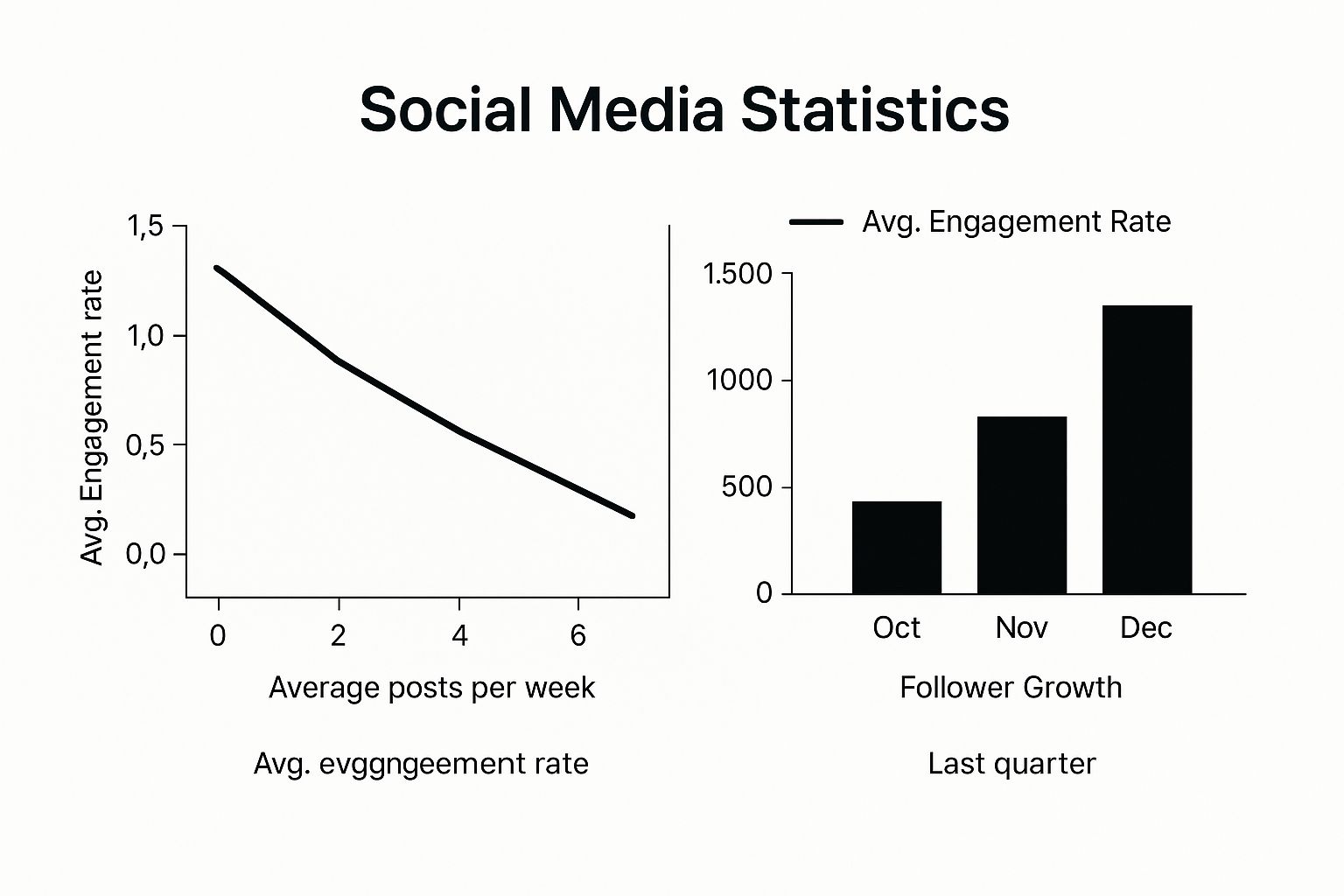
You can see a clear pattern: as posting becomes a habit, your engagement rates and follower numbers climb in tandem. It’s a direct cause-and-effect relationship.
Here's a simple framework to put this all into practice. It’s all about tracking the right metrics to understand what's truly driving your growth.
Key LinkedIn Growth Metrics to Monitor
| Metric | What It Reveals | How to Act On It |
|---|---|---|
| Engagement Rate | The percentage of people who saw your post and interacted (liked, commented, reposted). This is a core indicator of content quality. | Double down on the formats and topics that get the highest engagement. If carousels outperform text posts, make more carousels. |
| Comments per Post | The number of genuine conversations your content is starting. This signals deep resonance and community-building. | Identify posts with high comment counts. What questions did you ask? What opinions did you share? Replicate that approach. |
| Profile Views | How many people are curious enough to check you out after seeing your content or comments. It shows your brand is compelling. | If views are low, make sure your posts have a clear call-to-action or your comments are insightful enough to make people want to know more about you. |
| Follower Growth | The net new followers you gain over a specific period. This is the ultimate sign that your overall strategy is attracting an audience. | If growth is stagnant, look at your content's reach. Are you using relevant hashtags? Are you engaging in other communities? |
Ultimately, you want to create a simple feedback loop for yourself. Every few weeks, take a moment to review your best-performing content. Look for patterns. Was it the topic? The format? The time you posted?
By consistently doing more of what works and cutting what doesn't, you stop hoping for growth and start engineering it. If you want to get more formal about it, understanding a broader set of social media KPIs can provide a more structured approach to measuring success.
Your LinkedIn Growth Questions, Answered
As you start putting these strategies into practice, you're bound to run into some specific, practical questions. Getting a feel for LinkedIn's quirks can be tricky, so let's clear up a few of the most common hurdles people face.
Think of this as your quick-reference guide for the day-to-day decisions that truly shape your growth. Getting these details right—from how often you post to whether paid features are worth it—is what separates a fleeting effort from a sustainable, powerful presence.
How Often Should I Actually Be Posting on LinkedIn?
This is the big one, isn't it? The truth is, there's no single magic number. The goal is to find a rhythm you can actually stick with, one that delivers real value to your audience without burning you out. If you're bombarding your network with content every single day, they'll tune you out. But if you post too rarely, you’ll never build any momentum.
For most professionals looking to build a presence, posting two to three times a week is the ideal starting point. This is frequent enough to keep you on people's radar and signals to the LinkedIn algorithm that you're an active, engaged member of the community. It also gives you enough space to create thoughtful, quality content rather than just posting for the sake of it.
Consistency trumps frequency, every single time. It's far better to publish two fantastic posts every week like clockwork than it is to drop five rushed, low-value ones. Your network will start to anticipate your content, which is how you build a loyal following.
Is LinkedIn Premium Really Worth the Money?
LinkedIn Premium can be a game-changer, but only if you use it for the right reasons. It's not a silver bullet for instant growth, but it does unlock some powerful features that can give your efforts a serious boost. Whether it’s worth the cost comes down entirely to what you’re trying to achieve.
Let’s look at who benefits the most:
- Job Seekers: Absolutely. Seeing who's viewed your profile, getting bumped to the top of recruiter lists, and accessing salary data can make a huge difference in a job search.
- Sales Professionals: Sales Navigator is the key here. It provides incredible search filters, smart lead recommendations, and the ability to contact people beyond your immediate network—all essential for effective prospecting.
- Personal Branding: The main perk is the expanded "Who's Viewed Your Profile" list. This is a goldmine. You can see exactly which individuals are checking you out, giving you a perfect, warm opening to connect and start a conversation.
If your day-to-day involves active prospecting, selling, or networking, Premium can easily pay for itself. But if your main focus is building authority through content creation, the free version is more than enough to get started.
I Haven’t Posted in Years. How Do I Get Back in the Game?
Jumping back in after a long hiatus feels like a bigger deal than it is. The good news is you're not starting from scratch. You already have a network, even if it's been quiet for a while. The trick is to be deliberate about how you re-engage.
Here’s a simple, four-step plan to get things moving again:
- Give Your Profile a Refresh: Before you post a single thing, go back through the profile optimisation checklist. Make sure your headshot, headline, and 'About' section are all up-to-date and reflect your current goals. This is your foundation.
- Warm Up Your Network: For the first week, just focus on engaging. Don't post. Scroll through your feed and leave genuine, thoughtful comments on what your connections are sharing. Congratulate people on their work anniversaries. This simple act reminds people you’re there and gets you back on their radar.
- Make a Low-Key Return: Your first post back shouldn’t be a big, splashy "I'm back!" announcement. Instead, just share something of value. It could be an insight from a recent project, a lesson you've learned, or your take on an industry trend. Lead with generosity from day one.
- Lock in a Schedule: Once you’ve broken the ice with that first post, commit to your new, sustainable schedule. Whether it's two or three times a week, stick to it. Consistency is what will rebuild your presence and prove to your network that you’re here to stay.
Remember, reactivating a profile is a marathon, not a sprint. Focus on consistent, valuable actions, and you’ll regain your footing faster than you think.
Stop guessing what to post and start growing your brand with content that feels like you. With Trustypost, you can generate on-brand post ideas and schedule your content in minutes, not hours. See how effortless social media can be by starting your free 7-day trial.

